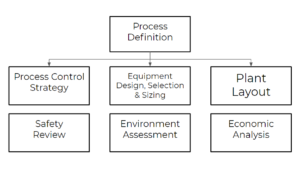1 Project Scoping
Learning Objectives
By the end of this section, you should be able to:
Define the components of a design basis memorandum
Phases in the Construction of a Plant
Chemical plant construction can be split into four broad stages which come one after another:
- Basic Engineering – the scale of the plant, the draft of the process flow diagram (PFD, we will introduce this later in the course), cost estimation, preliminary schedule, etc.
- Detailed Engineering – client approved PFDs, a detailed construction schedule, real data of equipment costs from venders, etc.
- Construction
- Commissioning (start-up)
In this course, we will only focus on basic engineering.
What do we produce as engineers?
Basic Design Package: This document is provided to clients by engineers and may consist of the following:

A thorough basic engineering design package can be found on the website of Startail Management and Consulting Services.
Design Basis Memorandum (DBM): This document contains key information and data related to the project deliverables.
A design basis memorandum is typically 10-20 pages and mainly consists of the following information:
- Contractual issues
- Project scope
- High-level description of the product to be made
- Feeds used in the process
- Technology description
- Plant capacity and location
- Product specification
- Composition purity
- Temperature
- Pressure
- Operating philosophy
- Deliverables and schedule
- Gantt chart
- Project scope
- Plant site-specific issues
- Feed specifications
- Temperature
- Pressure
- Composition
- Utilities
- Emission requirements
- What the site can emit according to local law
- Site environmental conditions
- Atmospheric pressure
- Wind
- Maximum and minimum temperatures
- Rainfall
- Environmental and safety issues
- Control and electrical requirements
- Feed specifications
- Design-specific issues
- Equipment, instrument, and line numbering
- Units
- Standards
- Certain technical equipment have certain standards (pressure vessels, heat exchangers, electrical work)
Process Design Scope
The discussion of what is inside and outside battery limits is usually established early in the design process to give a clear indication of what engineers are responsible for in their design.
- Inside Battery Limits: equipment and components that are associated with the main process feed streams [latex]^{[1]}[/latex], such as piping on process fluid streams.
- Outside Battery Limits: equipment, components, utilities, and other facilities acting on the utilities or waste treatment (not included in inside battery limits) that are associated with the process, but not related to the current design scope. [latex]^{[1]}[/latex]
Example: DBM Content – Production of Vinyl Chloride
Say we want to build a plant that produces 360,000 tonnes per year of a vinyl chloride monomer ([latex]C_{2}H_{3}Cl[/latex]) to be used in the production of polyvinyl chloride (PVC). One reaction pathway is shown below.
[latex]C_{2}H_{4} + Cl_{2} → C_{2}H_{4}Cl_{2}\;\;\;\;\; (1)[/latex]
[latex]C_{2}H_{4}Cl_{2} → C_{2}H_{3}Cl + HCl\;\;\;\;\; (2)[/latex]
A DBM for this process might consist of the following items:
For contractual issues:
- High level description of vinyl chloride and uses
- Ethane and chlorine feeds to be used
- Reactor type being used
- Plant capacity of 360,000 tonnes/yr of vinyl chloride, located in Houston, Texas
- Operating composition purity, temperature, and pressure
- Operating philosphy
- Gantt chart showing project timeline
For site-specific issues:
- Temperature, pressure, and composition of feed (inside battery limits)
- Cooling water used at [latex]25 ^{\circ}C[/latex] and 2 atm and steam at [latex]20^{\circ}C[/latex] and 3 atm (outside battery limits)
- Emission predictions and requirements
- Atmospheric pressure, little wind and rainfall, maximum and minimum temperatures at location
- Environmental and safety issues at locations
- Control and electrical requirements of the plant
For design-specific issues:
- Equipment, instrument, and line numbering
- Units used in calculation (imperial or SI)
- Standards
- Certain technical equipment have certain standards (pressure vessels, heat exchangers, electrical work)
Exercise: Classifying Inside & Outside Battery Limits
Consider a process where benzene is fed into a process for oxidization and purification in a plant. The process also consists of using 2 utility streams (cold water and steam) used in heat exchangers in the plant, as well as an onsite wastewater treatment operation. Your company has been hired to do basic engineering for the oxidation and purification process. Classify the oxidation, purification, wastewater treatment, and utility supply as either inside battery limit or outside battery limit.
Solution
- Oxidation: inside battery limit – this will be done of the benzene feed (primary) stream
- Purification: inside battery limit – this will be done of the benzene feed (primary) stream
- Waste Water Treatment: outside battery limit – in this case, wastewater treatment is a secondary process and not within the design scope.
- Utility supply: outside battery limit – in this case, utilities are secondary process elements
Note that in other cases the outside batter limit elements above could be included inside the battery limits depending on what the client asks the engineering design firm to do. However with our example above we had clearly stated the design firm was only focusing on the oxidation and purification steps.
References
[1] CII – CII Glossary. [Online]. Available: https://www.construction-institute.org/resources/knowledgebase/about-the-knowledge-base/glossary/cii-glossary. [Accessed: 29-May-2020].


Feedback/Errata